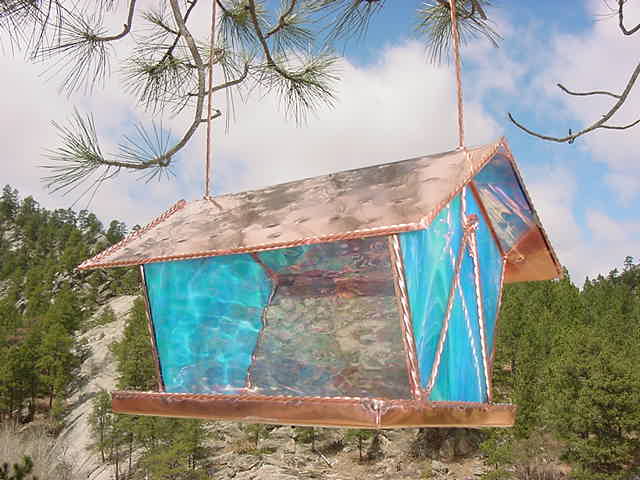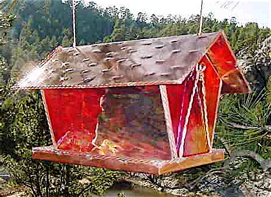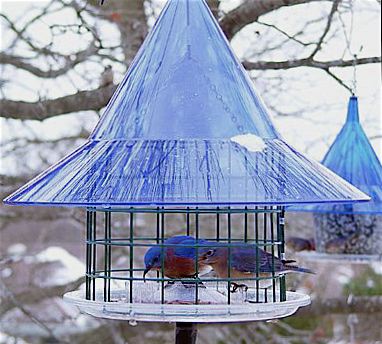-
an artful glass bird feeder
Now glass birdhouses may not be such a great idea as severe weather conditions can wreak havoc on inside temperatures. Extreme heat (if in the line of direct sun) may not be so healthy for eggs or hatchlings.
Glass bird feeders on the other hand, can add a fantastic focal point to the garden or yard. True works of art, the hand crafted glass bird feeders feature a long lost kind of art, and it shows in the craftsmanship.
This copper and stained glass bird feeder features a hand hammered roof, and the generous tray allows for multiple perching spots so several birds can feed at once. The overhang roof helps to protect seed form the elements, while the large capacity hopper holds several ponds of any seed mix. This artist features several vibrant hues of stained glass, and custom work is always a pleasure to create. If you’re stumped for a great Valentine’s gift that will last for years… and actually be admired and enjoyed, consider a work of art – a one-of-kind glass bird feeder in your choice of colors!
-
Death in the Bat Caves:
Disease Still Wiping out Hibernating BatsScientists suggest a roadmap to tackle disease which has killed over one million bats
California, February 2011 – Conservationists across the United States are racing to discover a solution to White-Nose Syndrome, a disease that is threatening to wipe out bat species across North America. A review published in Conservation Biology reveals that although WNS has already killed one million bats, there are critical knowledge gaps preventing researchers from combating the disease.
WNS is a fatal disease that targets hibernating bats and is believed to be caused by a newly discovered cold-adapted fungus, Geomyces destructans, which infects and invades the living skin of hibernating bats. Since 2006 about one million bats across six species in eastern North America have died from WNS, and as a result several species of bats face endangerment or extinction.
“White-Nose Syndrome was first documented in 2006 in a tourist cave near Albany, New York. Dead and dying bats were then found in four nearby caves, 30 km west of Albany,” said lead author Janet Foley from the University of California, Davis. “By July 2010 G.destructans was identified in hibernating bats in 13 states as well as in Ontario and Quebec across the Canadian Border.”
Affected bat species include the endangered Indiana and gray bats (Myotis sodalis and M. grisescens), little brown bat (M. lucifugus) and the cave bat (M. velifer). Infection has also been confirmed in five species of bats in Europe, although no similar epidemic has yet been recorded.
The low temperatures and humid conditions of bat caves create ideal breeding grounds for this fungus, and in some bat colonies the mortality rate from WNS has been more than 95%.
“Some bats in infected bat colonies behave abnormally when infected, choosing to hibernate in exposed places, such as cave entrances or even flying during the day,” said Foley. “Bats regularly arouse from hibernation in order to drink, urinate and relocate. This causes them to burn up their only source of energy during winter, the body fats they stored prior to winter when insect prey was still available. Fungal infection might be leading to more frequent arousals from hibernation, causing infected bats to use up their fat reserves earlier, with potentially fatal consequences.”
Although the effects of the disease are all too apparent, there are critical knowledge gaps for researchers confronted with combating the disease. It remains unclear if G. destructans is the only pathogen involved, how it causes mortality, and its means of transmission. Some evidence suggests that people can move the fungus from cave to cave.
“Our study considers how epidemiology and disease ecology can help fill these knowledge gaps,” said Foley. “We believe that a roadmap including bat monitoring and disease surveillance, coupled with active research into finding ways to treat individual bats will be vital to combating this disease.”
“Based on current data, we believe that the culling of bats would be both premature and ill-advised. Instead we see efforts to conserve the genetic diversity of bat populations, combined with a program of educating the public to be key parts of the roadmap.”
Dr Foley’s team includes bat and disease ecologists from three different public agencies and academia and tries to make the point that creative, scientifically-sound ideas will be key to the success of any management plans. The group outlines an outbreak investigation framework that includes establishment of diagnostic standards, case definitions, and gathering of information on potential treatments for similar diseases.
The importance of monitoring bat population health is also stressed, as is improving public education and awareness of the disease, especially as many species of bats live in caves popular among tourists. If current declines in bat populations continue, the researchers expect strong reductions in the ability of bats to reduce insect pests and play important ecological roles in unique cave ecosystems.
The team also call for further studies of the chemical or biological agents that can kill the fungus, but have yet to be proven safe for bats.
“In the three years since its discovery WNS has changed the focus of bat conservation in North America,” concluded Foley.. “A national response is required and our epidemiological roadmap is designed to help inform state and national efforts to combat WNS across North America.”
This study is published in Conservation Biology. Media wishing to receive a PDF of this article may contact [email protected]
-
Innovative mealworm feeder
Waaay cool, the makers of the Sky Cafe have created a mealworm feeder specifically for bluebirds. The new Sky Cafe is totally squirrel proof for starters. The design will keep larger birds out, thus saving precious mealworms for your bluebirds. The large baffle, or hat, also protects food and birds from the elements. A high quality mealworm feeder that may be pole mounted or hung, you know will be around for many years of use and enjoyment
There are lots of groovy dish-type mealworm feeders out there, but as soon as birds discover the tasty morsels, the worms will disappear in no time flat! Seems lots of birds love mealworms… especially live ones.
If you’re forever running to the store in order to keep your mealworm feeder filled, you may want to consider buying them in bulk. It’s far more economical if you’re feeding live worms. Stored in the fridge, the worms stay in a dormant state until they’re warmed up, so no worries of creepy-crawly things in your fridge! The bedding used is nothing more than wheat bran, purchased at your local grocery store.
If you’ve been trying to attract bluebirds with no luck…live worms are the ticket! Bluebirds seem to find this precious food source quickly, and will stick around if mealworms are fed on a consistent basis. Our bluebirds have braved the tough winters of North Georgia for the past few years now… ever since their mealworm feeder is always stocked with live worms. The heated baths help too, and it’s got to be this combination that has allowed us to witness so many successful broods!
Here’s to spring!



